Sizing & Fitting: the synergy that makes your ride perfect
Have you ever wondered why some people seem born on their bike, while others struggle to find a comfortable and efficient position?
The answer, largely, lies in two fundamental concepts: sizing and fitting.
Sizing: the foundations of your tailor-made bike
The so-called sizing is the initial process of determining the ideal size of a bicycle frame. Imagine building a house: before you start thinking about the color of the walls or the type of parquet, you need to establish the dimensions of the rooms and the general layout of the rooms. The sizing is exactly that: it defines the proportions of your future frame, based on the unique characteristics of your body.
Thanks to the Digital Sizing by Gregario, today you can get custom sizing from the comfort of your own home. Through measurements and, with the subsequent dedicated interview, we are able to determine the correct size of your VERA frame kit, thus creating a solid foundation for a bicycle that is tailored to your uniqueness.
Despite some inevitable limits of precision and repeatability of measurement taken through web apps, our Digital Sizing offers an extremely good starting point. We bring you a concrete example: in the image below you see the superimposed sizing obtained with two measurements (made with different phones and setups) of the same cyclist, while the table shows the measurements of the segments and the coordinates of the contact points obtained.
Although the two measurements provided different results for almost all segments (with peaks up to 16 mm), the calculated contact points fall well within the adjustment ranges on VERA seatpost, saddle, stem and handlebar.
| Measurement 1 [mm] | Measurement 2 [mm] | Difference (2-1) [mm] | |
| Shoulders | 356 | 365 | +9 |
| Torso | 548 | 541 | -7 |
| Arm | 316 | 306 | -10 |
| Forearm | 304 | 291 | -13 |
| Femur | 471 | 455 | -16 |
| Tibia | 410 | 425 | +15 |
| Resulting coordinates for the contact points | |||
| Xs | 215 | 207 | -8 |
| Zs | 735 | 733 | -2 |
| Xc | 593 | 593 | 0 |
| Zc | 652 | 641 | -11 |
Fitting: the final refinement for a tailor-made ride
The fitting instead, is a more in-depth process that focuses on fine-tuning the rider’s position on the bike. Once the frame has been built to the dimensions determined by the sizing, the fitting allows you to further refine the position, acting on elements such as:
- – Saddle and seat post: height, advancement (or retreat)
- – Stem and handlebar: height (using raisers or playing on the stem inclination) and possibly also length (changing the supplied attack with a tailored version)
Fitting is essential to optimize your performance, reduce the risk of injury and ensure maximum comfort while pedaling. Moreover, it is not just a one-time procedure, it must be repeated on a regular basis to correct seasonal variations or to compensate for temporary conditions.
Sizing and fitting: a winning combination
Finally, it is important to underline that sizing and fitting are two complementary phases and not in competition with each other. Once the VERA frame kit is built with the correct sizing, what is needed to achieve optimal positioning will be easily recoverable with the micro-adjustments in a bike fitting session. On the contrary, if the starting point is a frame kit with inadequate measurements, even the most expert bike fitter will find himself in difficulty and the result will always be a frustrating compromise for everyone.
Of course, for those who want enhanced precision, it is possible to perform multiple measurements. A statistical approach allows us to reduce the impact inaccuracies from a single measurement, however even without this further refinement, our Digital Sizing is able to provide a reliable result thanks to the flexibility of the adjustments offered by the VERA frame kit.
To conclude:
- – The sizing provides the foundation for a custom-made bicycle, ensuring the frame is the correct size for your body.
- – The fitting allows you to refine your position on the bicycle, optimizing your performance and comfort.
Our Digital Sizing service offers you the possibility of obtaining an accurate and personalized sizing of the frame, without having to leave home. However, to get the most out of your custom-made bicycle, you will always have to rely on a professional bike fitter, who will be able to integrate the evaluation with analysis of the power expressed and pedaling dynamics, or investigate any specific critical issues. Since the starting point is well calibrated to your characteristics, the bike fitter’s work will be much more rewarding, he will finally be able to focus on optimization through micro-adjustments and will not have to be embarrassed saying that the frame is wrong and compromises need to be made.






